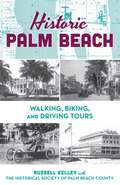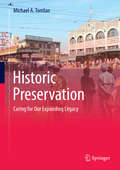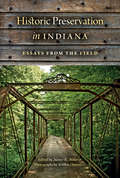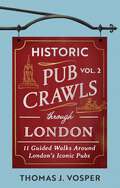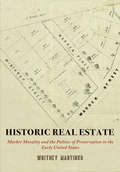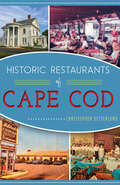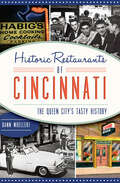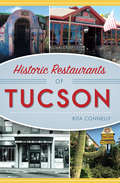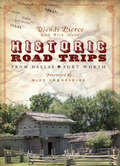- Table View
- List View
Historic Palm Beach: Walking, Biking and Driving Tours
by The Historical Society of Palm Beach County Russell KelleyDiscover the remarkable transformation of Palm Beach through three expertly curated historical tours that bring 150 years of history to life. Step back in time as you explore Palm Beach's evolution from wilderness to wonderland through this unique guide featuring 150 rare vintage photographs from the Historical Society of Palm Beach County's archives. Whether you're a history buff, architecture enthusiast, or curious traveler, this comprehensive guide offers three distinct ways to experience Palm Beach's rich heritage: A 10-mile driving tour showcasing Palm Beach's evolution from Pioneer Era to present day, including optional walking detours to legendary mansions A scenic 5-mile Lake Trail bike tour following the original Pioneer Era pathway along Lake Worth An intimate walking tour through the historic midtown district, revealing the stories behind iconic Worth Avenue and Royal Park Addition From Henry Flagler's magnificent hotels to Addison Mizner's architectural masterpieces, each tour combines detailed maps, historical context, and vintage photographs—many showing lost landmarks like the famed Royal Poinciana Hotel. Experience Palm Beach's fascinating journey from frontier outpost to America's premier resort destination.
Historic Philadelphia: An Illustrated History
by James SmartHistoric Philadelphia: An Illustrated History by James Smart
Historic Plantations of Alabama's Black Belt
by Jennifer HaleOnce the center of agricultural prosperity in Alabama, the rich soil of the Black Belt still features beautiful homes that stand as a testimony to the region's proud heritage. Join author Jennifer Hale as she explores the history of seventeen of the finest plantation homes in Alabama's Black Belt. This book chronicles the original owners and slaves of the homes, and traces their descendants who continued to call these plantations home throughout the past two centuries. Discover why the families of an Indian chief and a chief justice feuded for over a century about the land on which Belvoir stands. Follow Gaineswood's progress as it grew from a humble log cabin into an opulent mansion. Learn how the original builder and subsequent owners of the Kirkwood Mansion are linked together by a legacy of exceptional and dedicated reservation. Historic Plantations of Alabama's Black Belt recounts the elegant past and hopeful future of a well-loved region of the South.
Historic Powder Houses of New England: Arsenals of American Independence (Landmarks)
by Matthew E. ThomasIn the turbulent history of colonial New England, more than two hundred powder houses were built to store gunpowder, guns and armaments. Even the spark from a metal shoe nail could ignite their contents, so they often sat in remote sections of town. These volatile storehouses played a vital role in earning and preserving American independence. It was, after all, to a powder house in Concord, Massachusetts, that the British army marched in April 1775 to seize colonists' gunpowder. The British were thwarted, and the colonists' defense of the powder house ignited the Revolutionary War. Add to this the duels, murders, public hangings and tragic explosions that checkered the history of these structures, and the reader will discover a fascinating and forgotten aspect of our New England heritage. Using meticulous research, Matthew Thomas narrates the colorful histories of New England's powder houses as he resurrects their historical significance in early American history.
Historic Power Europe: A Post-Hegelian Interpretation of European Integration (Critical European Studies)
by Davide BarileThis book proposes a new theoretical framework to move beyond the traditional tenets of modern international relations theory to investigate European integration and shed light on current events. Based on contemporary analyses, Hegel’s political philosophy, and the fundamental role of historical interpretation, this book addresses the institutional dynamics as well as the discursive practices behind both the Eastern enlargement and the current critical situation. Looking back in particular at European integration in one of its most significant events, namely the enlargement of the European Union to include former Socialist countries, it offers a unique conceptualisation of the nature and limits of European integration and for understanding the current crisis between Brussels and the Visegrád countries, 30 years since the revolutions of 1989. This book will be of key interest to scholars and students of European integration, European politics and history, and political theory and philosophy.
Historic Preservation
by Michael A. TomlanThis well-illustrated book offers an up-to-date synthesis of the field of historic preservation, cast as a social campaign concerned with the condition, treatment and use of the legacy of existing properties in the United States. Drawing on a wide range of research, experience and scholarship over the last fifty years, it allows us to re-think past and current ideas in preservation, challenging readers to explore how their own interests lie within the cognitive framework of the activities taking place with people who care. "Who" is involved is explored first, in such a way as to explore "why", before examining "what" is deemed important. After that the questions of "when" and "how" to proceed are given attention. The major topics are introduced in an historical review through the mid-1980s, after which the broad intellectual basis and fundamental legal framework is provided. The economic shifts associated with major demographic changes are explored, in tandem with responses of the preservation community. A chapter is dedicated to the financial challenges and sources of revenue available in typical preservation projects, and another chapter focuses on the manner in which seeing, recording, and interpreting information provides the context for an appropriate vision for the future. In this regard, it is made clear that not all "green" design alternatives are preservation-sensitive. The advocacy battles during the last few decades provide a number of short stories of the ethical battles regarding below-ground and above ground historic resources, and the eighth chapter attempts to explain why religion has been long held at arm's length in publicly-supported preservation efforts, when in fact, it holds more potential to regenerate existing sites than any governmental program.
Historic Preservation and the Livable City
by Eric W. Allison Lauren PetersFor both the preservation professional and urban planner, this book shows how preservation is a key to the creation of livable cities. The author Eric Allison, the founder and coordinated of the graduate historic preservation program at Pratt Institute in New York City, offers tools and case studies that preservationists and planners can learn from in implementing preservation projects or plans in cities large and small. This book is a must read for anyone working in or interested in these fields and the creation and maintenance of livable cities.
Historic Preservation in Indiana
by Nancy R. HillerOver the last half century, historic preservation has been on the rise in American cities and towns, from urban renewal and gentrification projects to painstaking restoration of Victorian homes and architectural landmarks. In this book, Nancy R. Hiller brings together individuals with distinctive styles and perspectives, to talk about their passion for preservation. They consider the meaning of place and what motivates those who work to save and care for places; the role of place in the formation of identity; the roles of individuals and organizations in preserving homes, neighborhoods, and towns; and the spiritual as well as economic benefits of preservation. Richly illustrated, Historic Preservation in Indiana is an essential book for everyone who cares about preserving the past for future generations.
Historic Preservation, Third Edition (Third edition): An Introduction To Its History, Principles, And Practice
by Norman Tyler Ted J. Ligibel Ilene R. TylerThis classic text covers the gamut of preservation issues in layman’s language. Historic preservation, which started as a grassroots movement, now represents the cutting edge in a cultural revolution focused on “green” architecture and sustainability. This book provides comprehensive coverage of the many facets of historic preservation: the philosophy and history of the movement, the role of government, the documentation and designation of historic properties, sensitive architectural designs and planning, preservation technology, and heritage tourism, plus a survey of architectural styles. An ideal introduction to the field for students, historians, preservationists, property owners, local officials, and community leaders, this thoroughly revised edition addresses new subjects, including heritage tourism and partnering with the environmental community. It also includes updated case studies to reflect the most important historic preservation issues of today; and brings the conversation into the twenty-first century.
Historic Preservation: An Introduction to Its History, Principles, and Practice (Second Edition)
by Norman Tyler Ted J. Ligibel Ilene R. TylerHistoric preservation, which started as a grassroots movement, now represents the cutting edge in a cultural revolution focused on "green" architecture and sustainability. This is the only book to cover the gamut of preservation issues in layman's language: the philosophy and history of the movement, the role of government, the documentation and designation of historic properties, sensitive architectural designs and planning, preservation technology, and heritage tourism, plus a survey of architectural styles. It is an ideal introduction to the field for students, historians, preservationists, property owners, local officials, and community leaders. Updated throughout, this revised edition addresses new subjects, including heritage tourism and partnering with the environmental community.
Historic Pub Crawls Through England: 11 Guided Walks Around England's Iconic Pubs and Landmarks (Historic Pub Crawls)
by Thomas J. Vosper'Britain is full of amazing pubs and this man will guide you to the very best' Phil CarrAfter spontaneously hosting a birthday pub crawl through London's finest alehouses, Thomas J. Vosper was inundated with requests from friends and family to make it a regular occurrence. And so, Historic Pub Crawls was born; a curated guide of fun, accessible and fact-filled walks which have taken social media by storm. Now, he's back-bigger and boozier-with Historic Pub Crawls of England!Taking in London, Liverpool, Birmingham, St. Albans, Brighton, Nottingham, Newcastle, Gateshead, York and Manchester, this guide takes you on expertly curated walks through 10-15 historic pubs in each city. Sip a pint at some of the country's oldest pubs, explore York's medieval streets, or soak up Manchester's industrial charm.Whether you're a history buff, a beer enthusiast, or just up for a great night out, this book is your ticket to unforgettable pub adventures. Grab a copy, gather your mates, and start your crawl!
Historic Pub Crawls Through England: 11 Guided Walks Around England's Iconic Pubs and Landmarks (Historic Pub Crawls)
by Thomas J. Vosper'Britain is full of amazing pubs and this man will guide you to the very best' Phil CarrAfter spontaneously hosting a birthday pub crawl through London's finest alehouses, Thomas J. Vosper was inundated with requests from friends and family to make it a regular occurrence. And so, Historic Pub Crawls was born; a curated guide of fun, accessible and fact-filled walks which have taken social media by storm. Now, he's back-bigger and boozier-with Historic Pub Crawls of England!Taking in London, Liverpool, Birmingham, St. Albans, Brighton, Nottingham, Newcastle, Gateshead, York and Manchester, this guide takes you on expertly curated walks through 10-15 historic pubs in each city. Sip a pint at some of the country's oldest pubs, explore York's medieval streets, or soak up Manchester's industrial charm.Whether you're a history buff, a beer enthusiast, or just up for a great night out, this book is your ticket to unforgettable pub adventures. Grab a copy, gather your mates, and start your crawl!
Historic Pub Crawls Through London, Vol. 2: 11 Guided Walks Around London's Iconic Pubs and Landmarks - the perfect gift for Father's Day (Historic Pub Crawls)
by Thomas J. VosperAfter spontaneously hosting a birthday pub crawl through London's finest alehouses, Thomas J. Vosper was inundated with requests from friends and family to make it a regular occurrence. And so, Historic Pub Crawls was born; a curated guide of fun, accessible and fact-filled walks which have taken social media by storm.Covering areas such as Mayfair, Regent's Park, Shoreditch and Richmond, this guide takes you on expertly curated walks through 10-15 historic pubs across the heart of the capital. Sip a pint overlooking the Thames, wander past the awe-inspiring Royal Albert Hall, take a stroll through Jack the Ripper's neighbourhood, or admire the iconic collections at the British Museum.Whether you're a history buff, a beer enthusiast, or just up for a great day out, this book is your ticket to unforgettable pub adventures. Grab a copy, gather your mates, and start your crawl
Historic Pub Crawls Through London, Vol. 2: 11 Guided Walks Around London's Iconic Pubs and Landmarks - the perfect gift for Father's Day (Historic Pub Crawls)
by Thomas J. VosperAfter spontaneously hosting a birthday pub crawl through London's finest alehouses, Thomas J. Vosper was inundated with requests from friends and family to make it a regular occurrence. And so, Historic Pub Crawls was born; a curated guide of fun, accessible and fact-filled walks which have taken social media by storm.Covering areas such as Mayfair, Regent's Park, Shoreditch and Richmond, this guide takes you on expertly curated walks through 10-15 historic pubs across the heart of the capital. Sip a pint overlooking the Thames, wander past the awe-inspiring Royal Albert Hall, take a stroll through Jack the Ripper's neighbourhood, or admire the iconic collections at the British Museum.Whether you're a history buff, a beer enthusiast, or just up for a great day out, this book is your ticket to unforgettable pub adventures. Grab a copy, gather your mates, and start your crawl
Historic Pub Crawls Through New York: 10 Guided Walks Around New York's Iconic Pubs and Landmarks (Historic Pub Crawls)
by Thomas J. VosperAfter spontaneously hosting a birthday pub crawl through London's finest alehouses, Thomas J. Vosper was inundated with requests from friends and family to make it a regular occurrence. And so, Historic Pub Crawls was born; a curated guide of fun, accessible and fact-filled walks which have taken social media by storm. Now, he's back-bigger, boozier and star-spangled -with Historic Pub Crawls of New York!From quiet, old Irish boozers to bustling dive bars, this guide takes you on expertly curated walks through 10-15 historic pubs across the heart of Manhattan. Stroll along the scenic High Line, dip into lesser known spots in tourist areas such as Times Square and Broadway, or enjoy a drink at some of the United States' oldest drinking establishments in the financial district.Whether you're a history buff, a beer enthusiast, or just up for a great night out, this book is your ticket to unforgettable pub adventures. Grab a copy, gather your mates, and start your crawl!
Historic Ranches of Northeastern New Mexico (Images of America)
by Baldwin G. BurrIn 1866, Charles Goodnight and his partner Oliver Loving began rounding up feral cattle in Texas, forming herds to be driven north into the immense unoccupied grazing land in northeastern New Mexico. The counties of Colfax, Mora, Harding, Union, and San Miguel became the location of some of the great historic ranches of the West. From the 11,000-acre Chase Ranch in Colfax County to the 650,000-acre Bell Ranch in San Miguel County, these ranches have been home to several generations of ranching families. Pioneer ranchers such as Manley M. Chase, Frank and Charles Springer, Samuel Watrous, and Albert K. Mitchell established a tradition of perseverance, self-sufficiency, and sustainable range management that continues to the present day.
Historic Real Estate: Market Morality and the Politics of Preservation in the Early United States (Early American Studies)
by Whitney MartinkoA detailed study of early historical preservation efforts between the 1780s and the 1850sIn Historic Real Estate, Whitney Martinko shows how Americans in the fledgling United States pointed to evidence of the past in the world around them and debated whether, and how, to preserve historic structures as permanent features of the new nation's landscape. From Indigenous mounds in the Ohio Valley to Independence Hall in Philadelphia; from Benjamin Franklin's childhood home in Boston to St. Philip's Episcopal Church in Charleston, South Carolina; from Dutch colonial manors of the Hudson Valley to Henry Clay's Kentucky estate, early advocates of preservation strove not only to place boundaries on competitive real estate markets but also to determine what should not be for sale, how consumers should behave, and how certain types of labor should be valued.Before historic preservation existed as we know it today, many Americans articulated eclectic and sometimes contradictory definitions of architectural preservation to work out practical strategies for defining the relationship between public good and private profit. In arguing for the preservation of houses of worship and Indigenous earthworks, for example, some invoked the "public interest" of their stewards to strengthen corporate control of these collective spaces. Meanwhile, businessmen and political partisans adopted preservation of commercial sites to create opportunities for, and limits on, individual profit in a growing marketplace of goods. And owners of old houses and ancestral estates developed methods of preservation to reconcile competing demands for the seclusion of, and access to, American homes to shape the ways that capitalism affected family economies. In these ways, individuals harnessed preservation to garner political, economic, and social profit from the performance of public service.Ultimately, Martinko argues, by portraying the problems of the real estate market as social rather than economic, advocates of preservation affirmed a capitalist system of land development by promising to make it moral.
Historic Restaurants of Billings (American Palate Ser.)
by Stella Fong Greg PatentBillings exploded when the railroad arrived, and good food was here to stay. Montana Avenue anchored the first establishments serving oysters, chop suey and steaks. Modern comfort arrived with the Northern Hotel and never left. Locals sipped, savored and swung at the Skyline, Bella Vista, Elmo and Windmill Supper Clubs from the 1930s to the 1960s. Entrepreneurs debuted the Level 3 Tea Room, La Toque, Bruno's and New Moon Cafe. Beef still reigns at the Rex, Jake's and Bistecca at the Granary. Writer Stella Fong testifies why names like Yegen, McCormick, Schaer and Honaker have persisted throughout Billings' culinary history.
Historic Restaurants of Cape Code (American Palate)
by Christopher SetterlundA guide to the storied Massachusetts eateries that have left an indelible mark on their customers.Author Christopher Setterlund details the history of the iconic establishments of the Cape, still fresh in the memories of patrons, complete with famous recipes. Bill and Thelma&’s was hugely popular with students from the 1950s to the 1970s, often packed with locals after sporting events and dances. Starbuck&’s Restaurant in Hyannis featured the Chief Justice Warren Burger Burger and the Larry Bird Burger on its menu and boasted of the soup du jour, &“We don't know what it is, but we have it every day.&” Opinions differ on how the Reno Diner actually got its name, whether from a broken sign or a local appliance company. This fun collection is sure to arouse some fond memories of these old eateries, and perhaps a little hunger too.&“Forty chapters—one each for 39 restaurants and another for some recipes—make for a delicious and nostalgic read.&” —Barnstable Patriot
Historic Restaurants of Cincinatti: The Queens City's Tasty History (American Palate Ser.)
by Dann WoellertA Cincinnati food writer shares a fascinating and fully illustrated homage to the Ohio City&’s culinary history and most beloved eateries. Cincinnati is the home to food innovations, rivalries and restaurants that stand the test of time. The Queen City boasts the invention of both Cincinnati chili and goetta, the beloved breakfast meat. Legendary establishments like Mecklenburg Gardens, Arnold&’s, Izzy&’s and Scotti's have all operated for over a century. The French restaurant Maisonette was the epitome of fine dining, and Wong Yie&’s Famous Restaurant elevated America&’s Chinese cuisine from street fare to an exotic experience. Busken Bakery and Frisch's vied for Cincinnati pumpkin pie supremacy by taking digs at each other through billboards and redecorating a Big Boy statue in Busken attire. Author Dann Woellert explores the most iconic eateries, the German influence on Queen City food and what makes dining so unique in Cincinnati.
Historic Restaurants of Tucson (American Palate)
by Rita ConnellyTucson's culinary journey began thousands of years ago, when Native American tribes developed an agricultural base along the Santa Cruz River. In modern times, restaurants ranging from tiny taquerias to fine dining spaces all contributed to the local food culture. El Charro, serving Mexican cuisine since 1922, still attracts crowds from all over. Folks head straight to Pat's for a hot dog, Lucky Wishbone for some fried chicken or eegee's for a grinder and a cold, frosty drink. On any given night, the patio at El Corral is filled with diners anticipating their famous prime rib and tamale pie. Local food writer Rita Connelly brings to life the stories of beloved eateries that have endured for decades and continue to delight with incredible flavors.
Historic Restaurants of Washington, D.C.: Capital Eats (American Palate Ser.)
by John DeFerrariDiscover the culinary heritage of America&’s capitol with this guide to Washington, D.C.&’s historic restaurants and storied local eateries. While today&’s foodies enjoy the latest culinary trends of Logan Circle and the H Street corridor, Washington's first true restaurants opened around 1830. Waves of immigrants introduced a global mix of ingredients to the capital&’s eager palates by opening eateries like the venerable China Doll Gourmet and Cleveland Park's Roma Restaurant. By the twentieth century, the variety and quality of cuisine was astounding. Diners could have tea at Garfinckel's Greenbrier or lunch at local favorites such as Little Tavern Diner or Ben's Chili Bowl. For an elegant evening, fine restaurants like Rive Gauche and the Monocle satisfied the most sophisticated gastronome. With careful research and choice recipes, &“Streets of Washington&” blogger John DeFerrari chronicles the culinary and social history of the capital through its restaurants, tasting his way from the lavish Gilded Age dining halls of the Willard Hotel to the Hot Shoppe's triple-decker Mighty Mo.
Historic Rhode Island Farms (Landmarks)
by Robert A. GeakeDating back to the colonial era, the historic barns and outbuildings of Rhode Island have withstood the test of time. From the state's early barnyard taverns to the modern-day horse and dairy farms that populate rural Rhode Island, each of these buildings has a story to tell. In the mid-eighteenth century, the Narragansett planters bred horses on their farms in southern Rhode Island. Later, dairy farms sprang up across the region. Milking barns were built on the largest farms in the state, including the Theinhert Dairy Farm and Barn in Lincoln. Before the advent of electric trolleys, urban barns sheltered horses for early tramcar transportation. Each barn is a beloved reminder of the state's history. Join author Robert A. Geake as he explores the origins and evolution of Rhode Island's farms.
Historic Richmond Churches & Synagogues
by Walter S. Griggs Jr. Robert DillerRichmond’s historic houses of worship cannot be separated from the city’s storied past. A young Patrick Henry sparked a revolution with his “Give Me Liberty or Give Me Death” speech inside St. John’s Episcopal Church on Church Hill. Congregation Beth Ahabah, with its awe-inspiring windows and adjoining museum, is one of the oldest and most revered synagogues in the country. An interstate highway was moved to save the Sixth Mount Zion Baptist Church, where John Jasper asserted, “De Sun do move,” in the most famous sermon ever preached in the city. Beloved local author Walter Griggs Jr. tells the compelling history of Richmond’s most holy places.
Historic Road Trips from Dallas/Fort Worth
by Wendi PierceRick Steed and his driving companion, Wendi Pierce, set off with one goal in mind: to travel Texas's old fort trails and scout today's remnants of the bloody skirmishes and battles of long ago. Historic Road Trips from Dallas/Fort Worth provides not only a road map of day trips throughout Texas but also a narrative history of the tiny towns, historic markers and frontier excitement along the way. After collecting these stories for years, Steed teamed up with Pierce to bring to life this fascinating guidebook for anyone who yearns to venture off the main road and discover old Texas. Each drive begins in the Dallas/Fort Worth area and travels a different route through the state. Travel along and discover the site of Buffalo Hump's revenge raid or Cynthia Ann Parker's harrowing pioneer experiences, as well as other local lore, including the haunting of Jefferson, Texas's Jefferson Hotel, the notorious New London school accident and much, much more.
